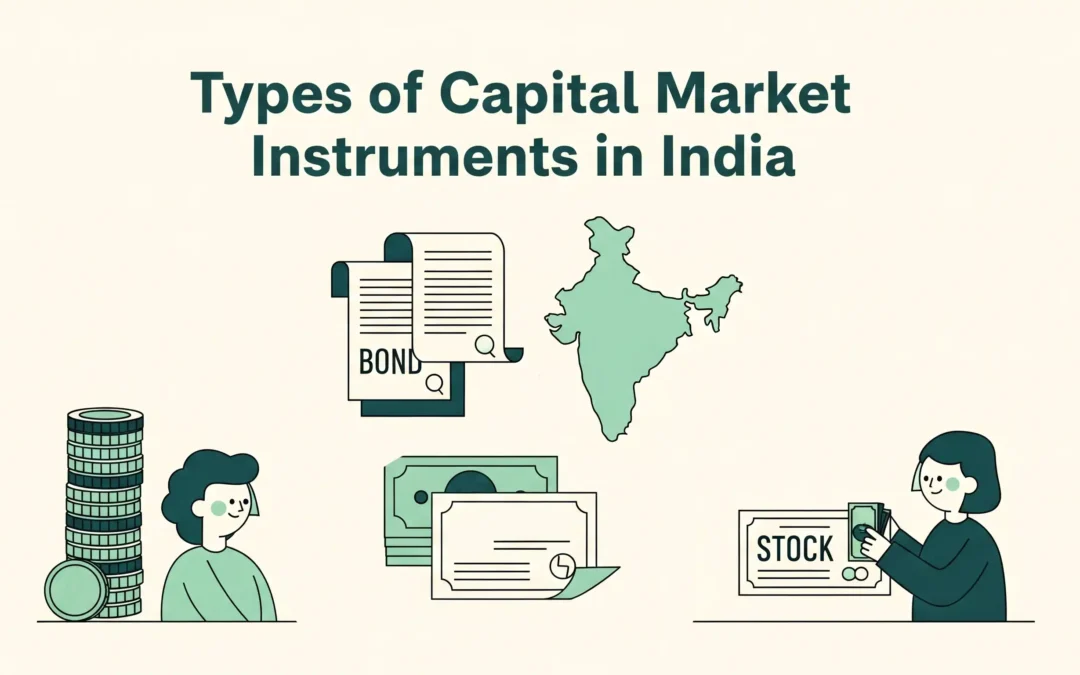India is a developing country. Government and businesses often require money for their growth and development, which they raise from the public. The public also expects something in return, and hence, interest or a proportion of ownership is given to them in exchange for their capital.
But how many types of capital market instruments are there in India? This article will help you understand the detailed meaning and types of such instruments that are popular in India. Let us dive into detail for further clarity.
What Are Capital Market Instruments?
Financial assets known as capital market instruments are used by governments and businesses to raise long-term capital from the general public. The capital market, which consists of the primary market (new issues) and the secondary market (resale of securities), is where these instruments are traded.
They assist issuers in funding infrastructure or business expansion while enabling investors to increase their capital through fixed income, equity ownership, or hedging techniques.
Key Features:
- Long-Term in Nature: Usually applied to funding projects lasting more than a year.
- Liquidity: Easy entry and exit through trading on stock exchanges.
- Return Potential: Provides dividends, interest, or capital gains as returns.
- Regulated Environment: SEBI (Securities and Exchange Board of India) keeps an eye on things to make sure they’re fair and transparent.
- Risk Variability: From safe government bonds to high-risk equity shares, different instruments have varying degrees of risk.
Types of Capital Market Instruments in India
Let us look at the type of capital market instruments available in India:
1. Equity Share
- They stand for ownership in a business and are also known as common shares.
- Dividends and capital gains are how shareholders make money.
- They have the ability to vote on business decisions.
- The return is high, but so is the risk.
2. Preference Share
- They get “preference” if the company is liquidated in terms of getting the dividend.
- Typically do not have the ability to vote.
- Less return potential but safer than equity shares.
- Ideal for investors seeking a steady income with a small amount of equity exposure.
3. Debentures
- Companies can borrow money by issuing debentures, which are long-term debt instruments.
- Provide a set interest rate.
- Most debentures in India are unsecured and not backed by specific assets, though a few may be secured against company assets; secured debentures are less common.
- It is just a loan and doesn’t give any right to business ownership
- Perfect for people looking for steady profits.
4. Bonds
- Similar to debentures, bonds are frequently issued by corporations or government agencies.
- Government bonds are comparatively safer than corporate bonds.
- Over time, provide a fixed interest income.
- Ideal for investors who are risk-averse.
- Example: Government of India Savings Bonds.
5. Treasury bills
- It is also known as T-Bills.
- They are issued for a short duration, usually less than a year.
- Discounted and redeemed for face value.
- Since the government backs them, T-Bills have negligible credit risk; however, they are still subject to inflation and interest rate risks.
- Banks and institutions use it the most.
- For instance, a 91-day T-Bill.
6. Commercial Papers (CPs)
- Short-term, unsecured promissory notes that big businesses issue.
- Used to satisfy working capital requirements most of the time.
- Better returns but higher risk than T-Bills.
- The tenure spans from seven days to a year.
7. Certificates of Deposit (CDs).
- To raise short-term funds, banks and other financial institutions issue certificates of deposit (CDs).
- Interest rates and maturity dates that are set.
- Less profitable than CPs but safer.
- Typically, institutional and corporate investors use it.
8. Convertible Debentures
- A hybrid instrument that can be converted from debt to equity after a predetermined amount of time.
- Combines the security of a debenture along with the growth potential of equity
- Well-liked by investors seeking flexibility.
9. Options and Futures Derivatives
- These are contracts whose value is derived from underlying assets such as currencies, stocks, or indexes.
- Utilised for arbitrage, speculation, or hedging.
- Mainly include futures and options contracts traded on Indian exchanges; swaps are over-the-counter instruments and are not commonly traded in Indian capital market exchanges.
- It is an instrument with a high degree of risk, usually utilised by institutions or investors with experience.
Summary Table:
| Instrument | Risk Level | Return Type | Ideal For |
| Equity Shares | High | Dividends + Growth | Long-term investors |
| Preference Shares | Medium | Fixed Dividends | Income-focused investors |
| Debentures/Bonds | Low-Medium | Fixed Interest | Conservative investors |
| T-Bills, CDs, CPs | Low-Medium | Fixed Returns | Short-term liquidity seekers |
| Derivatives | Very High | Capital Gain | Traders & Institutional buyers |
Bottomline
The conclusion can be drawn that there are several types of capital instruments available in India. Investors choose one or more based on their suitability and interest. These instruments vary in terms of security, returns they generate, and many other factors. The investors select one that aligns the most with their investing style and objective.
It is always advised to diversify the portfolio to balance the overall risk and return. Relying on only one instrument may lead to loss.


